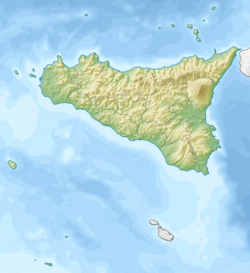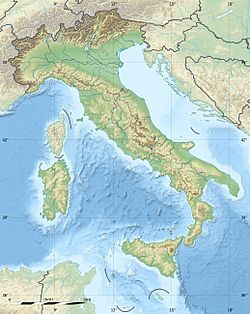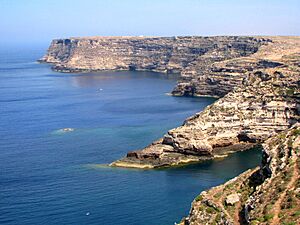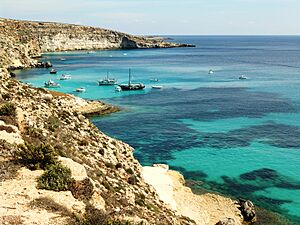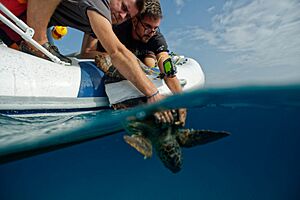Lampedusa facts for kids

Aerial view of Lampedusa
|
|
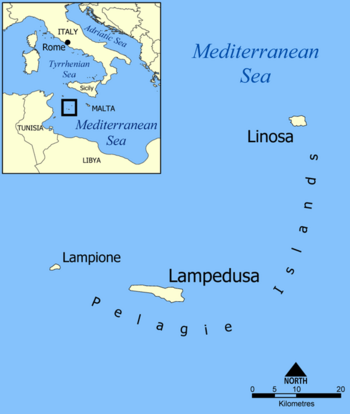 |
|
| Geography | |
|---|---|
| Location | Mediterranean Sea |
| Coordinates | 35°30′56″N 12°34′23″E / 35.515556°N 12.573056°E |
| Archipelago | Pelagie Islands |
| Area | 20.2 km2 (7.8 sq mi) |
| Administration | |
|
Italy
|
|
| Region | Sicily |
| Province | Agrigento |
| Comune | Lampedusa e Linosa |
| Demographics | |
| Population | 6,462 (entire Lampedusa e Linosa Comune) (2021) |
Lampedusa (/ˌlæmpɪˈdjuːzə/ LAM-pih-DEW-zə, US also /-sə/ --sə, Italian: [lampeˈduːza]; Sicilian: Lampidusa [lambɪˈɾuːsa]; Maltese: Lampeduża) is the largest island in the Pelagie Islands. These islands belong to Italy and are located in the Mediterranean Sea.
The island is part of the Lampedusa e Linosa area. This area also includes the smaller islands of Linosa and Lampione. Lampedusa is the southernmost part of Italy. Tunisia is the closest country, about 113 kilometres (61 nautical miles) away. Sicily is farther, at 205 kilometres (110+1⁄2 nautical miles).
Lampedusa covers an area of 20.2 km2 (7+13⁄16 sq mi). About 6,000 people live there. The main jobs on the island are fishing, agriculture, and tourism. You can reach the island by ferry from Porto Empedocle in Sicily. There are also flights from Lampedusa Airport to cities like Palermo and Catania. During summer, more flights connect Lampedusa to other Italian cities.
In 2013, a place called Spiaggia dei Conigli ("Rabbit Beach") was named the world's best beach. This was chosen by the travel website TripAdvisor. Since the early 2000s, Lampedusa has become a main entry point for people coming to Europe. Many of these people are migrants from Libya and Tunisia.
Contents
What's in a Name? The Etymology of Lampedusa
The name Lampedusa comes from an old Greek name for the island. This name was Λοπαδούσσα or Λαπαδούσσα (Lopadoússa/Lapadoússa).
Some people think the name comes from the Greek word λέπας (lépas). This word means 'rock', which makes sense because the island has a rocky landscape. Others believe it refers to a type of oyster that was common there. Another idea is that the name comes from λαμπάς (lampás), meaning 'torch'. This might be because lights were placed on the island to guide sailors.
Lampedusa Through Time: A Brief History
Early Days of Lampedusa
For a long time, Lampedusa was a stop for ancient travelers. The Phoenicians, Greeks, and Romans used it as a place to land and a sea base. The Romans even had a factory there to make a special fish sauce called garum. In 812 or 813, Saracens attacked the island during the Arab–Byzantine wars.
Later, the island became part of the Kingdom of Sicily. In 1553, pirates from North Africa attacked Lampedusa. They took 1,000 people as slaves. Because of these pirate attacks, no one lived on the island for a while. In 1667, the island was given to Ferdinand Tomasi of Palermo. His family later tried to get people to live on the island again.
In the late 1700s, the Order of St. John had a small group of people on Lampedusa. They had a chapel and traded with pirates.
Lampedusa in the 1800s
In 1800, Prince Giulio Maria Tomasi leased Lampedusa to a Maltese merchant named Salvatore Gatt. Gatt brought Maltese workers, animals, and started farming. He also rebuilt an old castle. The British flag was raised for protection.
The British thought about taking over Lampedusa. They considered it as an option instead of Malta. However, Lampedusa's harbor was too small compared to Malta's. In 1814, the British decided not to have anything more to do with Lampedusa.
Later, in 1843, two warships from Naples arrived. They landed 400 soldiers and replaced the British flags with Neapolitan flags. This made the island part of the Kingdom of the Two Sicilies. In 1861, Lampedusa became part of the new Kingdom of Italy. The Italian government mainly used it as a penal colony (a prison island).
Lampedusa in the 1900s
During Second World War, a small Italian army group held Lampedusa. In June 1943, British forces took over the island without a fight. The Italian leader, Mussolini, allowed his soldiers to surrender because they had no water.
The first telephone connection to Sicily was set up in the 1960s. An electric power station was also built around that time.
In 1986, Libya fired two missiles at Lampedusa. This was in response to an American bombing. However, the missiles missed the island and landed in the sea, causing no harm. In 1989, U.S. Navy planes shot down two Libyan fighter jets near the island. A NATO military base on the island was closed in 1994 and given to the Italian military.
Lampedusa in the 2000s: A Gateway to Europe
Since the early 2000s, Lampedusa has become a main stopping point for migrants. These are people from Africa, the Middle East, and Asia who want to enter Europe. Many pay smugglers to help them get to Lampedusa by boat from Libya. When they arrive, the Italian government often moves them to centers on mainland Italy.
In 2009, the island's reception center for migrants became very crowded. It was built for 850 people but held almost 2,000. A fire later damaged a large part of the facility.

In 2011, many more migrants came to Lampedusa. This happened during the rebellions in Tunisia and Libya. By May 2011, over 35,000 people had arrived. Most were young men.
In July 2013, Pope Francis visited the island. He prayed for migrants and spoke out against those who profit from their journeys. In October 2013, a boat carrying over 500 migrants sank near Lampedusa. Many people died in this sad event.
In September 2023, more than 120 boats arrived in just 24 hours. They carried about 7,000 migrants, which was more than the island's total population. Most of these migrants were young men or children traveling alone. They came mainly from Tunisia, often due to worsening conditions there or to escape danger.
Island Features: Geography of Lampedusa
Lampedusa is the southernmost point and island of Italy. Even though it's part of Italy, its geology is more like Africa. The sea between Lampedusa and Africa is not very deep.
Lampedusa is a dry island with mostly low, scrubby plants. It has no natural sources of fresh water, relying on rain. The island slopes from west to east and from north to south. The southwestern side has deep valleys, while the southeastern part has shallow valleys and sandy beaches. The northern coast has cliffs, which are gentle on the east and steep on the west.
How Lampedusa Was Formed: Geology
Lampedusa is part of a larger area called the "Pelagian Province." This area is a part of the African Plate. Lampedusa is mainly made of limestone, which is a soft, white to creamy-yellow rock. The island is like a tilted block of this rock. The highest point is on the northwest coast, and the lowest is on the southeast coast. This area is also active with earthquakes.
Weather in Lampedusa: Climate
Lampedusa has a subtropical semi-arid climate. This means it has very warm, mostly dry, and humid summers. Winters are very mild and never have frost. The sea breezes help keep summer temperatures from getting too hot during the day. Lampedusa is one of the few places along the Mediterranean coast that has never recorded frost. The lowest temperature ever recorded was 2.2 °C (36 °F) on February 1, 1999.
| Climate data for Lampedusa AP 16 m. asl, 1961–1990 normals, extremes 1959–present | |||||||||||||
|---|---|---|---|---|---|---|---|---|---|---|---|---|---|
| Month | Jan | Feb | Mar | Apr | May | Jun | Jul | Aug | Sep | Oct | Nov | Dec | Year |
| Record high °C (°F) | 21.6 (70.9) |
23.0 (73.4) |
25.0 (77.0) |
26.9 (80.4) |
33.9 (93.0) |
37.7 (99.9) |
36.4 (97.5) |
37.8 (100.0) |
34.7 (94.5) |
33.9 (93.0) |
27.6 (81.7) |
23.0 (73.4) |
37.8 (100.0) |
| Mean daily maximum °C (°F) | 15.3 (59.5) |
15.3 (59.5) |
16.0 (60.8) |
17.9 (64.2) |
20.9 (69.6) |
24.5 (76.1) |
27.4 (81.3) |
28.5 (83.3) |
27.0 (80.6) |
24.0 (75.2) |
20.2 (68.4) |
16.8 (62.2) |
21.2 (70.2) |
| Daily mean °C (°F) | 13.6 (56.5) |
13.5 (56.3) |
14.2 (57.6) |
15.9 (60.6) |
18.8 (65.8) |
22.3 (72.1) |
25.2 (77.4) |
26.4 (79.5) |
25.0 (77.0) |
22.1 (71.8) |
18.4 (65.1) |
15.2 (59.4) |
19.2 (66.6) |
| Mean daily minimum °C (°F) | 11.9 (53.4) |
11.8 (53.2) |
12.4 (54.3) |
13.9 (57.0) |
16.7 (62.1) |
20.1 (68.2) |
23.0 (73.4) |
24.3 (75.7) |
23.0 (73.4) |
20.1 (68.2) |
16.7 (62.1) |
13.5 (56.3) |
17.3 (63.1) |
| Record low °C (°F) | 2.8 (37.0) |
4.0 (39.2) |
5.4 (41.7) |
7.4 (45.3) |
11.0 (51.8) |
14.1 (57.4) |
17.4 (63.3) |
18.0 (64.4) |
16.3 (61.3) |
10.7 (51.3) |
7.6 (45.7) |
4.4 (39.9) |
2.8 (37.0) |
| Average precipitation mm (inches) | 42.6 (1.68) |
29.7 (1.17) |
23.6 (0.93) |
21.5 (0.85) |
6.0 (0.24) |
2.3 (0.09) |
1.0 (0.04) |
2.8 (0.11) |
15.5 (0.61) |
59.3 (2.33) |
63.3 (2.49) |
51.5 (2.03) |
319.1 (12.56) |
| Average precipitation days (≥ 1.0 mm) | 7.4 | 4.7 | 3.8 | 2.6 | 1.3 | 0.5 | 0.1 | 0.4 | 2.0 | 5.8 | 5.5 | 7.1 | 41.2 |
| Average relative humidity (%) | 78 | 76 | 78 | 76 | 78 | 78 | 78 | 78 | 77 | 77 | 74 | 77 | 77 |
| Source 1: Servizio Meteorologico | |||||||||||||
| Source 2: Temperature estreme in Toscana | |||||||||||||
Amazing Animals: Wildlife of Lampedusa
The animals and plants on Lampedusa are similar to those found in North Africa. "Rabbit Island" (Isola dei Conigli), near Lampedusa's south coast, is a very important place. It's one of the last spots in Italy where the loggerhead sea turtle lays its eggs. This type of sea turtle is endangered in the Mediterranean Sea. The beach and the nearby island are now a nature reserve.
Other animals living near Lampedusa's coast include mantas and smaller dolphins. The waters around Lampedusa are the only place in the Mediterranean where pregnant great white sharks and their newborns have been seen. Recent studies also show that fin whales come to Lampedusa's waters in winter to feed. Even humpback whales, which are rare in the Mediterranean, have been seen around the island in recent years.
Lampedusa and Linosa used to be home to endangered Mediterranean monk seals. They were common until the 1950s, but they are probably gone from the island now. However, monk seals were spotted near Lampedusa in 2020, which gives hope they might return.
Images for kids
See also
 In Spanish: Lampedusa para niños
In Spanish: Lampedusa para niños


